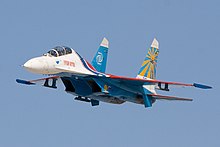Fixed-wing aircraft
| Subject classification: this is an engineering resource. |
A fixed-wing aircraft, more often called an aeroplane or airplane is a kind of aircraft. An aircraft is a machine that can fly, but is heavier than air. Fixed-wing aircraft are sometimes called just planes. All fixed-wing aircraft have wings. Gliders are fixed-wing aircraft that do not have engines.

History
[edit | edit source]A steam-powered unmanned fixed-wing aircraft, that weighed 9 lbs.[1], was built by John Stringfellow in England in 1848. It could fly by itself without needing to be dropped from high up. There were gliders before this, but they had to fly by being pushed off a building or hill.
The first man who flew (that is: took off, steered and landed) a motor-powered fixed wing aircraft was Orville Wright in 1903 in Kitty Hawk, North Carolina, USA.
Today, fixed-wing aircraft fly between many cities all over the world, bringing people and cargo. Big cities usually have an international airport, which is the place where fixed-wing aircraft can land and take off safely. Some large cities like New York City and London have more than one airport. Two large makers of fixed-wing aircraft are Airbus and Boeing.
Uses
[edit | edit source]The first aircraft for war bombing was used in Libya in 1911 by Italy against the Ottoman Empire. Some fixed-wing aircraft are used by air forces to defend countries. These fixed-wing aircraft may use guns or missiles for combat with other aircraft, or they may drop bombs on ground targets.Airplanes are also used by the military to see many things on the ground easily. This is called surveillance or reconnaissance.
Fixed-wing aircraft allow people to travel longer distances, and faster than ships or trains. Aircraft can fly from New York to London in about 7 hours. It would take one week or more on a ship.
